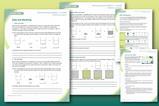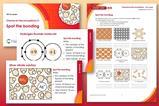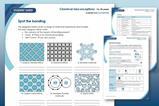This chapter reviews the ideas presented in earlier chapters and discusses how these ideas may be used to help students construct meaningful versions of concepts
The limitations of many student texts are considered, and some specific vignettes of classroom learning are used to illustrate key principles about teaching and learning.
Principles of constructing knowledge in the classroom
This publication has been written from a perspective - based on research into how learning occurs - known as ’constructivism’. This approach can be summarised in a few simple principles:
- People naturally, and actively, learn from their experiences, including, but by no means exclusively, experience in the classroom.
- Our brains are not equipped to take on board large amounts of learning wholesale, as we have to process information in a limited ‘mental scratch-pad’.
- Therefore, we need to break down information into manageable chunks that do not exceed the student’s processing capacity…
- … before being later ’reassembled’ into useful knowledge (and thus the references to constructing knowledge).
- Meaningful learning occurs when we can make sense of new information in terms of what we already know.
- Therefore, the ‘meaning’ of new information is heavily determined by prior learning.
- Students have already acquired a lot of ideas about scientific topics from their own practical experiences, and their interpretation of what they have been told, before they study those topics in school. This prior knowledge acts as the foundation on which new learning is constructed.
An experienced teacher comes to class with a vast storehouse of relevant ideas and knowledge relating to the topic being covered. In particular, the teacher has an overview of the wider conceptual framework within which the ideas fit.
The student usually arrives in the same class with a much more limited and incoherent knowledge base about the topic, having conceptual frameworks that may include key omissions, major fractures and intrusions of alternative notions from various sources. Each individual student brings their own set of associations for words to class, and makes their own interpretation of what the teacher says.
It is not surprising that what seems clear, simple and logical to the teacher may sometimes seem confused, complex and arbitrary to the student. Once we learn to recognise a pattern as a gestalt (of an atom, of an equation for neutralisation, etc) it requires a deliberate effort to decompose it into its constituent parts
A gestalt is an organised whole in which each part affects every other part, the whole being more than the parts. It is difficult for the teacher to see the subject matter at the resolution available to the student.
What is more surprising, perhaps, is how sometimes students may continue to make sense of the teacher’s ideas despite the most fundamental ‘misconceptions’.
The importance of diagnosing learners’ ideas
To the teacher the signs ‘+’ and ‘-’ relate to electrical charges that students would be expected to know about from their study of physics topics in school. However, teachers cannot assume the expected prior learning will be in place. Students may either be ignorant of the physical principles, or may simply not bring them to mind and apply them in a chemistry context.
The importance of formative assessment, testing to determine what learning objectives are yet to be achieved, is now being recognised as very important and teachers are being urged to adopt strategies ’to explore pupil’s progress and to help pupil’s learning’.
’Missing’ learning, and alternative conceptions can be major causes of learning difficulties for students. Auditing prior knowledge, and, in particular, diagnosing substantive learning impediments, are activities which can be cost-effective in terms of time and effort, and which can help avoid some of the frustration felt when students fail to leave a well planned and executed lesson with the intended understandings.
Notes
For the full version of this chapter, see downloads below.
Downloads
Constructing chemical conceptions
PDF, Size 0.82 mb
Websites
Additional information
These PDFs have been taken from the popular book, Chemical Misconceptions : Prevention, diagnosis and care: Theoretical background, Volume 1, by Keith Taber.

Chemical misconceptions
- 1
- 2
- 3
- 4
- 5
- 6
- 7
- 8
- 9
- 10
- 11
- 12
 Currently reading
Currently readingConstructing chemical conceptions
- 13
- 14
- 15
- 16
- 17
- 18
- 19
- 20
- 21
- 22
- 23
- 24
- 25
- 26
- 27
- 28
- 29
- 30
- 31
- 32
- 33
- 34
- 35
- 36





















































No comments yet